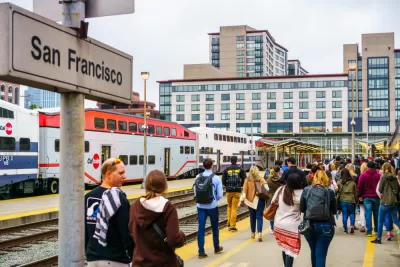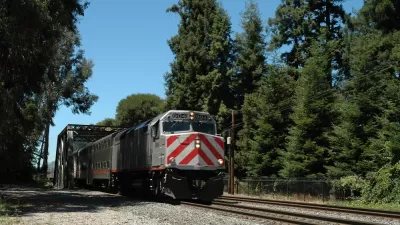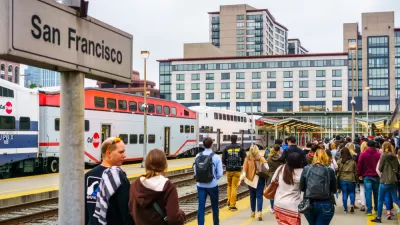The saga of the three-county sales tax upon which the future of Caltrain depends is now in the hands of voters.

"San Francisco's Board of Supervisors unanimously approved an eighth-cent sales tax measure for the November to fund Caltrain during a special meeting Friday -- the last day to place the measure on the county ballots," reports Daniel Montes.
The decision culminates weeks of political back and forth as political leaders from San Francisco, Santa Clara, and San Mateo counties held the sales tax measure as leverage in a battle over governance of the commuter rail system.
San Francisco and Santa Clara officials in July approved a version of the sales tax that San Mateo officials called dead on arrival. This latest version of the sales tax measure, with governance issues stripped from the measure that will appear before voters in November, came in just under the wire, and could save the beleaguered rail system. Earlier in July, the San Francisco County Supervisors rejected a version of the ballot measure approved by San Mateo county officials.
"If ultimately approved by two thirds of voters across San Francisco, San Mateo and Santa Clara counties, the tax would generate an estimated $108 million annually. The funding is desperately needed to operate the system as ridership has plummeted during the COVID-19 pandemic," according to Montes.
More than providing a lifeline during the diminished ridership of the pandemic, the sales tax measure is also intended to fund a major expansion of service on Caltrain, designed to be commensurate with existing service on the other regional transit system serving the San Francisco Bay Area—BART.
FULL STORY: Caltrain sales tax to be placed on November ballot after SF Supervisors pass measure

Study: Maui’s Plan to Convert Vacation Rentals to Long-Term Housing Could Cause Nearly $1 Billion Economic Loss
The plan would reduce visitor accommodation by 25,% resulting in 1,900 jobs lost.

North Texas Transit Leaders Tout Benefits of TOD for Growing Region
At a summit focused on transit-oriented development, policymakers discussed how North Texas’ expanded light rail system can serve as a tool for economic growth.

Using Old Oil and Gas Wells for Green Energy Storage
Penn State researchers have found that repurposing abandoned oil and gas wells for geothermal-assisted compressed-air energy storage can boost efficiency, reduce environmental risks, and support clean energy and job transitions.

Planting Relief: Tackling Las Vegas Heat One Tree at a Time
Nevada Plants, a Las Vegas-based nonprofit, is combating the city’s extreme urban heat by giving away trees to residents in underserved neighborhoods, promoting shade, sustainability, and community health.

How Madison’s Tree Planting Efforts Are Growing a Healthier Community
Madison’s annual tree planting initiative is enhancing environmental resilience, public health, and community livability by adding 1,400 carefully selected trees citywide, with strong community and institutional support for urban forestry.

Texas State Bills Could Kill Transit Funding in Dallas, Austin
State lawmakers could pull funding from the state’s largest transit agency and the ambitious Project Connect, a voter-approved transit project in Austin.
Urban Design for Planners 1: Software Tools
This six-course series explores essential urban design concepts using open source software and equips planners with the tools they need to participate fully in the urban design process.
Planning for Universal Design
Learn the tools for implementing Universal Design in planning regulations.
Ascent Environmental
Borough of Carlisle
Institute for Housing and Urban Development Studies (IHS)
City of Grandview
Harvard GSD Executive Education
Toledo-Lucas County Plan Commissions
Salt Lake City
NYU Wagner Graduate School of Public Service





























